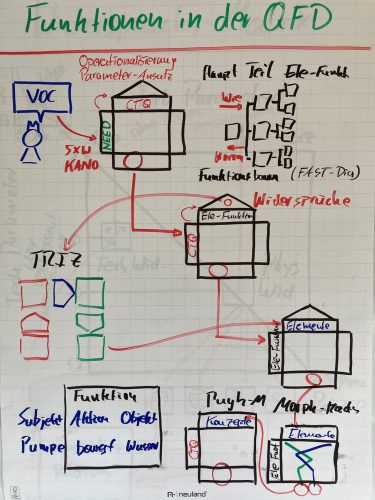Projektmanagement@GJW
DE
Funktionen in der QFD
Warum: Falls erforderlich tieferes Verständnis im Umgang mit Funktionen entwickeln und gegebenenfalls Kreativitätstechniken wie TRIZ vorbereiten.
.
Wie: Im >Planen< oder >Durchführen<, falls Konzeptentwicklung Teil des >Durchführen< ist, das Zusammenspiel von der Stimme des Kunden/VOC (Voice of the customer) über die Häuser der Qualität #1 bis #3 hin zum Lösungskonzept gestalten.
.
Was: Für das Anwenden von TRIZ ist ein tiefes Funktionsverständnis des Problems hilfreich. Daher sei hier die Abfolge der Häuser der Qualität (#1-#3) der QFD (Quality-Function-Deployment – Qualitätsfunktionendarstellung) dargestellt. Außerdem sind Werkzeuge verknüpft, die beim Zeilen-Spalten-Übergang innerhalb der Häuser helfen. Dreh- und Angelpunkt hier ist das Haus #2, in dem die CTQ mit den Elementar-Funktionen verknüpft werden. Zum Ermitteln der Elementar-Funktionen hilft ein Funktionsbaum oder FAST-Diagramm. In den Häuser werden im Dach jeweils mögliche Widersprüche der Spalteninhalte ermittelt. Im Haus #2 also die Widersprüche der Elementar-Funktionen. Solche Widersprüche lassen sich mit TRIZ bearbeiten. TRIZ liefert Ideen für Design-Elemente zum Realisieren der Elementar-Funktionen.
Davon ausgehend kann der Morphologische Kasten zur Konzeptentwicklung eingesetzt werden und anschließend die Pugh-Matrix zur Konzept-Auswahl/Bewertung.
Zum Verständnis der Funktionen lässt sich der Satzbau eines SPO (Subjekt-Prädikat-Objekt) Satzes nutzen. Das Subjekt führt die Aktion (Prädikat) mit Wirkung auf das Objekt aus. Die Funktion ist somit die Aktion/das Prädikat und das Objekt. In dieser Art sollten Funktionen immer formuliert werden.
EN
Functions in QFD
Why: Develop a deeper understanding of functions if necessary and prepare creativity techniques such as TRIZ if needed.
.
How: In >Plan< or >Execution<, if concept development is part of the >execution<, shape the interaction from the Voice of the Customer (VOC) through Houses of Quality #1 to #3 towards the solution concept.
.
What: A deep understanding of functions is helpful for applying TRIZ. Therefore, the sequence of Houses of Quality (#1-#3) of Quality Function Deployment (QFD) is presented here. Tools linked to facilitate the transition between rows and columns within the houses are also provided. The pivotal point here is House #2, where the CTQs are linked with the elemental functions. A function tree or FAST diagram aids in determining the elemental functions. Possible contradictions in the column contents are identified in the roofs of the houses. In House #2, these are the contradictions of the elemental functions. Such contradictions can be addressed with TRIZ. TRIZ provides ideas for design elements to realize the elemental functions.
Based on this, the Morphological Box can be used for concept development, followed by the Pugh Matrix for concept selection/evaluation.
To understand the functions, the sentence structure of a Subject-Predicate-Object (SPO) sentence can be used. The subject performs the action (predicate) with an effect on the object. Thus, the function is the action/predicate and the object. Functions should always be formulated in this way.
Geplante/Erforderliche Verbesserungen
tbd
